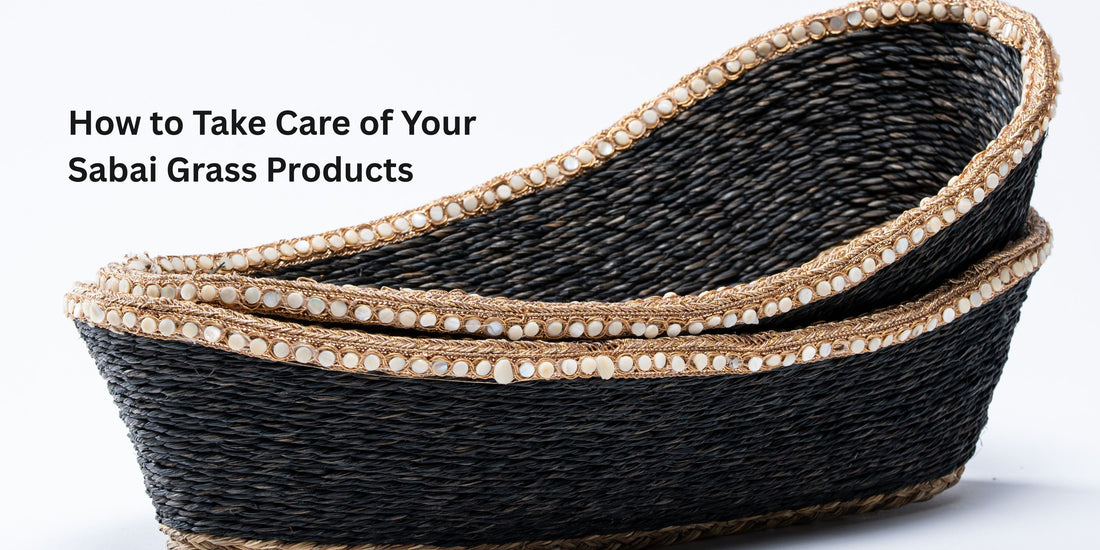
How to Take Care of Your Sabai Grass Products
Share
Every Sabai basket, mat, or bag you bring home carries a little story—of hands that wove it, of grass that grew wild and free, and of traditions that shaped it.
But like anything handmade with love, these pieces need a little love back.
Give them gentle care, and tada—they’ll stay with you for years, aging gracefully alongside your space.
In this guide, we’re sharing not just cleaning tips, but timeless care rituals—some passed down from artisans themselves—so your Sabai pieces stay as beautiful as the day you got them.
🧼 1. Regular Cleaning: Less Is More
Sabai grass is a natural fiber. It doesn’t need harsh cleaning agents or frequent washing.
For Daily Dust:
- Use a dry, soft-bristle brush or a microfiber cloth to gently wipe away dust.
- You can also shake out mats and baskets outdoors (like how we’d fluff handwoven rugs).

For Deeper Dust:
- Take a soft toothbrush or a clean paintbrush to get into the nooks and coiled curves—especially around edges of bags or basket corners.
Artisan Tip: Some rural communities gently rub a handful of dried neem leaves inside baskets once a month to keep bugs away while naturally freshening the fibers.
💦 2. Spot Cleaning: The Traditional Way
If your Sabai mat or basket has a small stain:
- Dip a cotton cloth in lukewarm water mixed with besan (gram flour)—a traditional, gentle cleanser used in Indian homes.
- Gently dab (don’t rub) the affected area.
- Wipe with a clean damp cloth and air dry in shade.

Why besan? It’s a natural absorbent that lifts grease without harming the fiber’s structure or color.
Avoid soaking the entire product in water. Sabai grass retains moisture and can lose its shape if soaked.
🌬 3. Sunlight + Air: The Natural Refresher
Every 3–4 weeks, air out your Sabai products outdoors—but always in indirect sunlight.
- Lay mats flat on a balcony or veranda.
- Hang baskets and bags upside down with clips to release trapped dust.
- Avoid damp or rainy days.
Old-School Method: In some villages, artisans sprinkle sun-dried turmeric leaves or dried orange peels inside storage baskets to refresh the scent and naturally repel pests.

🔥 4. Things to Avoid (No-Nos for Sabai)
❌ No machine wash
❌ No bleach or chemical detergent
❌ No direct heat or dryers

Instead, store in breathable cotton or jute bags—even an old pillowcase works well.
✨ 5. Maintaining Shape & Structure
If your Sabai bag or basket gets slightly bent:
- Lightly mist it with water using a spray bottle (not soak!).
- Gently reshape with hands.
- Let it dry naturally in shade.
Traditional Tip: Some artisans rub a tiny drop of mustard oil on fingers before reshaping baskets—this helps smoothen the bends without fraying.

🧴 6. Natural Polish for a Gentle Glow (Optional)
Want to refresh the look of your Sabai basket or tray?
- Mix a few drops of cold-pressed coconut oil with water.
- Lightly dab using a clean cotton cloth.
- Buff gently for a soft sheen—this works well for aged or slightly faded Sabai products.

Only apply once every 3–6 months, and always test on a hidden section first!
♻️ 7. Storage Tips (Seasonal & Long-Term)
- Always empty Sabai bags or baskets before storing.
- Add a clove or dried neem leaf inside if storing for long durations—it helps repel silverfish and moths.
- Avoid stacking heavy items on top.
🌿 Final Thoughts
Caring for Sabai products isn’t about rules—it’s about respecting the material and its makers. These are not mass-produced items—they’re woven stories, passed from hand to home with intention.
When you clean a Sabai piece using neem, or lay it under filtered sun, you’re doing what women in rural homes have done for generations. You’re not just preserving a product—you’re continuing a legacy.
